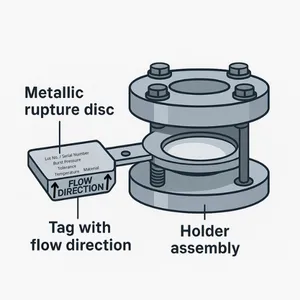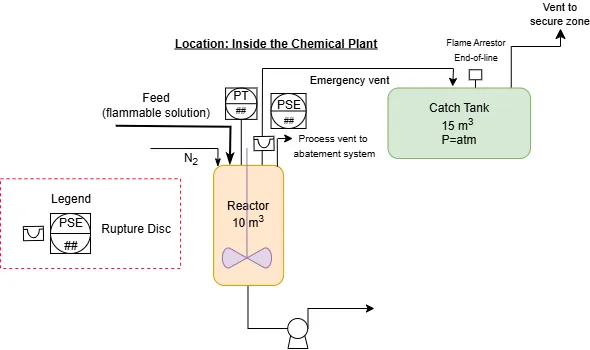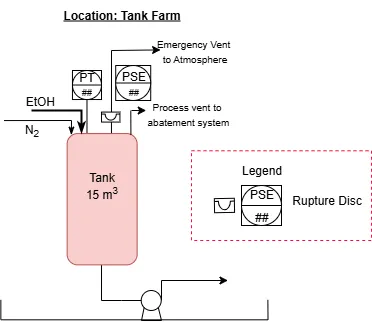
Rupture Disc Activation meaning
The activation of a rupture disc is a well-defined mechanical event: a non-reclosing pressure relief device opens at its specified burst conditions to protect equipment from overpressure beyond the equipment’s design limits.
The opening of a rupture disc generally indicates that the process has exceeded its allowable limits—pressure rose above the design or specified burst conditions, prompting the disc to open.
It is evidence of a process deviation and typically of a shortfall in one or more preventive barriers. The event should be recorded, investigated, and managed within the site’s Safety Management System (SMS), and classified using the applicable process-safety metrics.
Process Safety Event Classification (API RP 754: Tier 1–4)
Under API RP 754, Process Safety Events are grouped into four tiers that reflect loss of primary containment (LOPC) severity and barrier performance:
Tier 1 – Process Safety Event (Major Consequence)
A significant LOPC meeting Tier-1 threshold quantities or specified consequence criteria (e.g., injury, fire/explosion, off-site impact). Typically indicates failure of multiple protection layers and is fully reportable.
Tier 2 – Process Safety Event (Lesser Consequence)
A LOPC that meets Tier-2 threshold quantities or consequence criteria (lower than Tier 1). Still reportable as a process-safety incident.
Tier 3 – Challenge to Safety Systems
A challenge or demand on a safeguard (e.g., activation of a pressure relief device routed to a safe location) without a Tier 1/2 LOPC. Used as a leading indicator to prevent escalation.
Tier 4 – Operating Discipline / Weak Signals
Early-warning indicators (procedural deviations, audit findings, unsafe conditions/acts) that do not involve LOPC or safeguard demand. Used to monitor safety-management performance.
To frame rupture-disc activation within a process-safety context, we will examine two realistic scenarios and discuss their classification under API RP 754, noting that the actual tier depends on routing, quantity released, and consequences.
Case Study Illustration – Rupture Disc Venting to a Catch Tank

A reactor containing a flammable solution is protected by a rupture disc (non-reclosing PRD).
The vessel is nitrogen-inerted, reducing (but not eliminating) flammability hazards during normal operation.
If an overpressure excursion occurs, the disc bursts and the vapors are routed to a 15 m³ catch tank operated near atmospheric pressure and vented to a designated safe location.
An end-of-line flame arrester is installed on the vent to prevent flashback from the atmosphere into the catch tank.
Under these conditions, rupture-disc activation is typically a Tier 3 Process Safety Event (challenge to safety systems) when discharge is routed to a catch tank/safe location and no reportable LOPC occurs under API RP 754 (i.e., no Tier-1/2 threshold quantity or specified consequence criteria are met).
If the catch tank’s venting results in an actual atmospheric release, classification must follow the PRD-to-atmosphere rules of API RP 754: the event may be Tier 1 or Tier 2 if threshold quantities/consequences are met; otherwise Tier 3.
Consider the event a Near Miss only when it qualifies as Tier 3, to avoid normalizing PRD activations. Support the classification with a structured review (e.g., HAZOP/causal analysis), considering interlocks and their response, release duration/flowrate, and material hazards.
Case Study Illustration – Rupture Disc Venting to Atmosphere
The figure shows a typical ethanol storage tank with nitrogen blanketing, a rupture disc (non-reclosing PRD), and two vents: a process vent routed to an abatement system and an emergency vent direct to atmosphere. The rupture disc provides emergency overpressure protection; depending on the scenario, discharge may go to the abatement system or, if capacity/availability is insufficient, to the atmospheric emergency vent.

When the rupture disc activates due to overpressure, a release of ethanol vapors may occur because the emergency vent discharges directly to atmosphere. Unlike the catch-tank case, there is no intermediate containment and the discharge path is open air.
From a classification standpoint (API RP 754), PRD-to-atmosphere events are determined by the released quantity and specified consequence criteria. Depending on these, the event can be Tier 1 or Tier 2 (reportable PSE); if below Tier-1/2 thresholds and without the specified consequences, it may be Tier 3 (challenge to safety systems).
If the event is classified as Tier 3, the “Near Miss” label may be used, but apply it cautiously for PRD discharges to atmosphere. Treating atmospheric discharges as Near Misses can normalize rupture-disc activations: a burst is either a loss of primary containment (when discharged to atmosphere) or a demand on a safeguard (when routed to a safe location) and must not be downplayed.
In every situation, rupture-disc activation must be documented, investigated, and managed within the site’s Safety-Management System (SMS), using the API RP 754 tier structure to classify the event and drive follow-up actions.
📌 Note: Mixed-phase discharges (e.g., vapor–liquid dispersions, aerosols) can occur under conditions such as foaming, entrainment, or flashing. These scenarios are outside the scope of this case study but should be evaluated separately because they can change the applicable Tier and the required mitigation measures.
Recommended Actions Following Disc Activation
To ensure consistent treatment of rupture disc events, the following actions are recommended:
- Immediate notification of the EHS and engineering team;
- Isolation and securing of the affected equipment, if applicable;
- Initial assessment of potential environmental or safety impact;
- Formal deviation report, even if no release occurred;
- Root Cause Analysis (RCA) or simplified causal review, depending on severity;
- Review of process alarms, interlocks, and operator response leading up to the event;
- Verification of disc specification (e.g., burst pressure, corrosion, fatigue);
- Update of the PHA, if the event reveals previously unidentified scenarios.
Ing. Ivet Miranda
Looking to Build a Stronger Foundation in Chemical Engineering? Start Here:
- What does it mean to be an Engineer?
- What Does a Chemical Engineer do in Industrial Environments?
- Chemical Engineer Salary
- Unit Operations: A Practical Introduction for Engineers
- What is Distillation?
- What is the process of distilling water, alcohol, and oils?
- The 4 Management System Pillars in a Chemical Plant
- FREE PDF 4 PILLARS OF SMS
- Engineering Approach to Thermodynamics
- Safety Relief Valve vs Rupture Disc: 5 Key Engi Insights
- Engineering Problem-Solving in 7 Steps
FAQ
What is a rupture disc (bursting disc) and how does it work?
A rupture disc is a non-reclosing pressure relief device that opens at specified burst conditions to protect equipment from overpressure.
What’s the difference between a rupture disc and a safety/relief valve?
Relief/safety valves reclose; rupture discs do not. They’re often used together (e.g., disc upstream of a PRV for tightness/corrosion isolation).
When is a rupture disc opening Tier 1/2/3 under API RP 754?
If it discharges to atmosphere, classification depends on released quantity and specified consequences (Tier 1/2 if thresholds are met). If routed to a safe location with no reportable release, it’s typically Tier 3.
What should we do after a rupture disc activation?
Notify EHS/engineering, secure the equipment, estimate release/impact, classify per API RP 754, perform root cause analysis, verify disc specification (burst at operating temperature), and update the PHA.